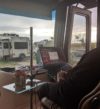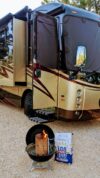We started seeing Joshua Trees as we drove south from Richfield, Utah to Las Vegas, NV. A bit of a misnomer, Google taught me that Joshua trees are part of the Yucca family. They grow only one to three inches per year, making them very slow-growing. They begin to branch out after they get to be a certain height (between three and nine feet). As they branch out, they take on an unusual shape. Couple this shape with the white yucca bloom at the end of the branch, and they seem other-worldly. They are known to live for a very long time, as suggested by their growth rate and the heights they reach. One Joshua Tree in California is thought to be over a thousand years old. We continued to see lots of Joshua Trees on our drive from Las Vegas to Palm Desert, but seeing all these did not prepare us for the masses of large Joshua Trees that we would find in Joshua Tree National Park.

The combination of so many Joshua Tree, massive rock formations, mountains all around us, and other desert plant life spread across the 792,510 acres that make up Joshua Tree National Park are what set it aside as a national treasure. This park connects the Colorado Desert (on the east side of the park at elevations below 3000 feet) and the Mojave Desert (on the west side of the park at elevations above 3000 feet). I had no idea that deserts could be so different from each other. Together they bring amazing diversity to this massive park.

Our campsite in Indio, California, was about 60 – 90 minutes away from any of the three entrances to Joshua Tree National Park. The West Entrance Station (near Joshua Tree Visitor Center) and the North Entrance Station (near Oasis Visitor Center) are both at the north end of the park. The 34-mile paved road, Park Boulevard, connects these entrances. Pinto Basin Road, the road at the South Entrance (Cottonwood Visitor Center), essentially connects to the eastern side of Park Boulevard. The roads combine for a total of about thirty-eight miles from the South Entrance to the North Entrance.
If you only have time for a couple of hours, I recommend that you drive Park Boulevard, the main road connecting the two entrances at the north end of the park. This drive allows you to see aspects of both the Colorado and the Mojave deserts. We spent two afternoons in the park. On the first afternoon, we drove Park Boulevard from the West Entrance to the North Entrance. We took our time and made numerous stops along the way, marveling at the unpredictable rock formations, climbing on a few very small rocks, and watching rock climbers maneuver their way up seemingly impossibly steep slopes. Joshua Tree is a rock climber’s paradise.

We took additional time to drive up to Keys View at 5185 feet. Here we walked up the path to look out at the Little San Bernardino Mountains and imagine the San Andreas Fault that exists just beyond.

We appreciated the beautiful vistas that the eastern side of the drive produced. Here, on the Colorado Desert side of the park, it seemed more like the desert we expected. And with daylight fading quickly, we left the park to drive into a beautiful sunset.

Part of our mission for our second visit to the National Park was to check out Box Canyon Road, a road south of the South Entrance, which we heard was great for biking. We entered the park at the South Entrance by way of this road, which, indeed, made for a great bike ride a few days later.

From the South Entrance, we headed north on Pinto Basin Road, the main road from the south entrance. Pinto Basin Road runs about 25 miles before joining up with Park Boulevard. Along this stretch of road, we paused to see more of the spectacular mountainous views of the Colorado desert part of the park.

As the road turned westward, evidence of the rocks and Joshua trees of the Mojave became a bigger piece of the drive’s scenery. About fifteen or so miles into the drive is the Cholla Cactus Garden. If you’re a non-desert native like us, you shouldn’t miss the Cholla Cactus Garden. What an awesome and unique section of the park.

Our weather on this second visit to the park was quite different than the first day. Strong winds blew across the road. Skies threatened to pour rain. Road signs warned of potential flooding. The feeling in the park was much different than the bright sunny blue-skied day we had our first time through. With storms coming from the west and blowing north-easterly and with our interest in seeing more of the Mojave side of the park, we made a left turn onto Park Boulevard. Our decision rewarded us by missing most of the rain, seeing a beautiful rainbow, and feeling blinded by intense sunshine reflecting off the wet pavement and rocks. The weather added to our feeling of being in another world.

Joshua Tree National Park is unlike any of the other parks that we have visited so far. The truth is, it is unlike any place we have seen or that I would have imagined. There are times, during our drives, where the scenery is so other-worldly, you might think you’re on another planet. And yet, we know that we are not on another planet. In fact, yet again in our adventures, we have proof of how diverse and how vast our country is. And this experience is truly AWE-some.
Notes for Future Visits:
- Drive north to south for the drive down Pinto Basin Drive out the south entrance and down Box Canyon Road. Box Canyon Road is very pretty as you head north towards the park, but is stunning as you head south.
- There’s lots of BLM land for boondocking just south of the south entrance to Joshua Tree NP
- There’s no water in the park, so be sure to bring lots.
- There’s no cell service in the park, so be sure to download maps.




One Reply to “Spending Time in Joshua Tree National Park”
Comments are closed.